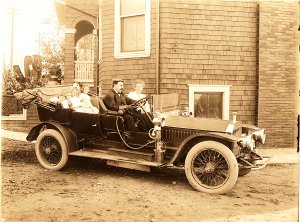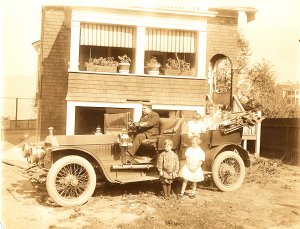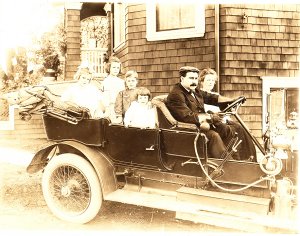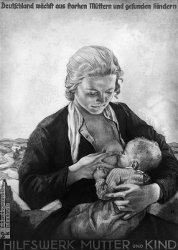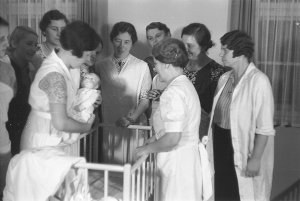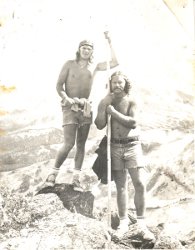Auto-Geneology: The Hager and Kuntze Family
from North America to Germany:
Different Love Affairs with the Automobile
by: Kelly Hagert
March 31st 2009
On a warm spring day, I look to my father Phil and notice a slight glimmer in his eye. “You know Kell,” he bellows with a smirk “ it was days like this that I loved, my hair flowing with the top down, the aroma of cherry blossoms in the air, catching all the pretty ladies looking my way.” 1 Sure, sure, pops, was my reply, you had flowing hair. In fact not only did he have flowing hair but he also owned one of the first convertibles out of his group of friends. He had owned his first convertible when he was twenty years old, a 1952 willies x army Jeep, with a new and advanced driving system of 4 x 4 off roading. In my dad’s eyes the world was wide open, even though the vehicle primarily got him to destinations such as work; the abundant option of freedom was at his fingertips. He was not the only one with this freedom.
This paper intends to look at my eclectic family, which consists of both German and Canadian descent. Even though both parents came from completely different upbringings, they both shared foundational personal experiences and similarities, in regards to automobiles. These similarities as will be discussed correlate to what many scholars deem as the era of the “fabulous 50’s.”2 Though aspects of leisure meant different things for my mother than my father; the social construction within the cities they resided, revolved around the automobile, this in turn paved new roads upon which both could travel. By interviewing both my parents and their siblings, it is clear that their experiences reflect that of a larger social context found within historical scholarly writings. Similarly, though personal experiences can change your outlook towards an automobile, the era upon which my parents and their siblings grew up, an overwhelming influence of Though taken largely from a personal perspective, these stories are windows of insight that provide a personal history for future generations to enjoy. This paper intends to show that however different cultural constructions may be, socially they share many more similarities than might originally meet the eye.
Philosopher Edward LiPuma explains that culture by-product of class, in which “the differential distribution of power within a class based on differential access of different fields of economic and/or symbolic power, maps unequal class fractions.”3 This attributes to the creation of different cultural scenarios. In the case of my parents, this statement could not be more accurate. Seeing that my mother grew up in Berlin, Germany, with the occurrence of World War 1 her lifestyle was much more repressed than that of my Fathers, who grew up the second son of a well off Vancouver family. Interestingly enough, although having very different upbringings upon interviewing them, one finds many foundational commonalities between the two youths. Although, similarities surfaced in a pool of differences, this essay will look at my father Phil and mother, Uschi, as well as one of each of their siblings. For my father, his sister Louise was interviewed; in addition for my mother her brother Michael was interviewed via phone call to Berlin. All interviews helped to piece together my family auto-genealogy; unfortunately all my grandparents have passed away, however through the memories of my family I have accumulated a few stories on their behalf. We will start with my father’s experiences with the automobile as well as his family.
The Hager’s, have a long lineage on the west coast of British Columbia. My fathers grandfather Alva Hager arrived in the Province from Boston in 1908, with intentions of go into the lumber business. “He had entered the fish business in 1901 with the New England Fishing Company” he came to British Columbia with the company, “which established the Canadian Fishing company Ltd., becoming one of the largest produces of fish in North America.”4 Alvah owned one of the smartest looking cars. A 1911 black Napier Colonial, interestingly enough this British brand was not the normal car for a industrial booming town like Vancouver. “Seated in their De Dion, Panhard, Gladiator, Renault, and Napier automobiles on the luxurious grounds of their estates, these women exuded elegant glamour.”5 Although this caption depicts that of women and the automobile an overlying theme of luxury is alluded to, this emphasises an elite feel to owning such a vehicle. Though this elite mentality was not something that my Great Grandfather portrayed through speech or action, “he will always be remembered for his unfailing courtesy with the little man,”6 he did through his vehicle. This automobile was a symbol of status, at a time where most vehicles on the road would be Ford Model T, any car on the road was a luxury in the early 1900’s specified for that of the upper class.
“At first the consumer base for automobiles was limited…. Cars were quite expensive in comparison with established commodities.”7 Where as come the 1920’s automobiles had become much more accessible in price, this saw a huge influx of automobiles into society in North America. “Between 1921 and 1925, Ford cut prices six times, resulting in a new Model T runabout carrying a price tag of only $260 in 1925.”8 Outings in the Napier were expressed through the grappling, agonizing stories of my grandfather Roger Hager. My dad vividly remembers while driving to our summer place in Crescent Beach (close to White Rock, BC) as my dad coyly shrugs mimicking the voice of his father “You know Philip, when asking are we there yet, you should be so lucky, well back in my day we did not have the luxury of driving right to Crescent Beach. Why, wouldn’t you know it, it truly was a family affair, when we were about half hour away from the beach house, all 9 of us children would have to get out and push the Napier up the dirt hill, consider yourself lucky to have the luxury of a paved road.” 9
Cars facilitated much change in how people commuted to work, (in my Great Grandfathers case to the fishery) moreover as mentioned above, the automobile opened venues of leisure activities as well as vacationing in remote destinations that were previously unattainable. “Crescent Beach used to take two hours to get to, the only road from Vancouver to Crescent was via New Westminster. Today with the Massey tunnel and highway 99 what used to take a few hours can be accomplished in 45 minuets.”10 This theme of leisure activity was similar in both my father’s family as well as my mothers. Here we see, although exposed to completely different cultures there are underlying principles that are shared between both the North American Culture and the European. “…we need to recognize that car culture is not simply something personal to us, but a complex global phenomenon.”11
One similar phenomenon correlated with the automobile was a sense of wandering, exploring, and freedom. The Germans would express it as a type of wanderlust. My father had his summer place to go to, while the automobile facilitated ways of venturing off into nature for my moms family. Unlike my father’s family, my mother’s family had very little after the tale end of world war two. “We left our beautiful home in East Berlin, we left everything, our whole life, in order to escape to West Berlin before the wall was erected.”12 The scars of war, left Germany in a war torn state the years after World War two, and many people could not afford a car. However my Opa, Klaus, did indeed own a vehicle. “It wasn’t until I was ten that we had a vehicle, we could not afford one.” My mom Uschi, fumbled and muttered, “I will never forget that car, it was a Ford, four door, the whole family could fit in it, cream colour with red interior. He (her father) was so proud to take it home, licence plate W-MD 42, Opa did not like the Volkswagen’s they were too small.”13 The logical reasoning why my mother’s parents bought an American car was due personal taste as well as shear expense of European cars. Criticism was set forth towards German automobiles claiming that they were “too expensive, standardization would only hurt the German automotive industry, and would be unable to compete with foreign auto firms that not only made technical progress through yearly model changes, but also were able to gain new consumers by marketing many automobile brands. The Kdf-wagen was no peoples car, it would remain to expensive for most Germans.”14 Moreover the “Model T was Europe’s best-selling car by a large margin.”15With this standardized mode of transportation, soon started the ever prominent tradition of Sunday afternoon drives, an event that both my father and mothers had while growing up. Somehow this was not instilled in us children (could be due to the fact that as my parents grew older, they began to learn to dread the Sunday afternoon drives).
With the automobile came freedom, something that any culture, disregarding where you were situated globally, benefited from this new venue of adventure. For both my parents this new outlet came in the family bonding experience of Sunday drives. For my father and his siblings, this was often a fun event, “It was a fun occasion,” my Aunt Louise joyfully expressed, “usually consisted of a wonderful drive around Stanley Park, or out to the Stevenson Cannery, this would all happen after church. When we were little, Rog (Grandpa) used to put us on his lap and we would pretend we were driving, oh how loved that.”16 However my mother, although excited to get in the car, often showed remorse when Sunday arrived, for it meant a 3 hour drive to the mountains, followed by her dad telling her how to properly keep up when trekking up the giant slopes. “After lunch, Opa would get in the car; we would get in the back seat, always my brother on the right and I on the left. There was no music, for it was too distracting, it was pure torture, I hated it.”17 This wandering is emphasised in historical documentation, supporting these claims, “We are still only beginning to rediscover the art of wandering by auto, A Sunday drive in Germany required not speed but patience and moderation, the ability to take ones time exploring the old peasant farm one sees on an incline or the old mill one finds off the beaten track… campgrounds created new possibilities.”18 For the mothers in the family this freedom came in the form of more independence. For my fathers mother there was much more independence than for my Oma in Germany.
“If he had it his way, the car would be in the bed room and my mother in the garage.”19 My uncle chuckled after making such a remark, “he was a tyrant, my mother did not have a license and it stood that way to the grave.” This was not a smart-alecky comment made by my uncle, but one that was supported by my mother. “ when we moved to Freiburg, I was about 16 or 17 years old, and I remember Oma asking Opa, that it would be nice to get a driving license. His reply was simple and abrupt ‘Why would you want that for, you have no where to go.’”20 This repressive nature, and dominant male role can be shown in the following pictures. Up until the 1990’s and even today, there is a strong belief that “women are responsible for cooking, cleaning and children (the three K’s in Germany).”21 My Oma was a typical example of a traditional image of a German housewife.
As for my Father’s mother it was quite the opposite. “Helen, owned a 1956 blue Ford ranch wagon, father had two cars a 1956 Lincoln Premier two toned dark blue top with a light blue bottom. My fathers car was great power everything which was rare at the time. He also owned a 1962 Mercedes 300 black with red leather interior.”22 Though most families by then owned two family cars, it was of great fortune to own three. The powered automobiles with all the bells and whistles aided my Grandma Helen in driving the children around town, as well as made accomplishing errands a lot easier. “for an extra nine dollars you could get seatbelts, for sixteen dollars … padded dashboards and sun visors… breakaway rear-view mirrors, crash proof door locks and steering wheels with recessed hubs.”23 No expenses were spared, for my Grandma, unlike my Oma, Helen was a very mobile independent woman. My Aunt Louise expressed this with much admiration and pride, “In her blue Ford station wagon, she would meander up the mountains, driving the CUBS to Seymour Mountain. She was a very independent woman, and owned a car well before marring Roger (this was something very few women had in the 1920’s). She didn’t even like skiing, while we would be taking lessons, she would sit in the lodge, smoking cigarettes and drinking coffee, when we were done, she would drive all the way back down to the city with us.”24 My grandma had the luxury freedom moreover she had a social network of friends and a society that respected the admiration of women to explore. Unlike my Oma, my grandma was encouraged to help the community by making her travel services available. “Women were traveling, and were traveling far, being transformed by a new technology, and in turn, helping to radically reshape the lives of women afar.”25 This statement is emphasised even more so in the image in the Vancouver Sun March 28th 1957 newspaper article, showing a woman involved in the personalize process of “beautifying” their automobile. This early independence of women could be said to have attributed to enabling them the right to vote. Moreover freedom was not only felt for mothers but birthed a new generation of liberty which glimmered in our parent’s era.
Freedom for Philly:
Even with a continental divide, both my parents as well as their generation reaped benefits from the independence automobiles gave youth. For my father this came with a price, as safety was not of primary concern when you are young and full of, as he put it, piss and vinegar. One could say my dad fell into as Peter Wollen and Joe Kerr state “… a communal dream predicted on our sense of speed, drama and aggression, the worlds of advertising and consumer goods…. In which our addition to driving will lead to an ever-growing overload of traffic.”26 In all fairness most men and women fell under this category, as cars became more numerous on roads, accidents increased, my dad is not a rare case. However he was one of the few to get severely hurt due to careless driving. “Ohhh I loved driving, especially my old Triumph 650 motor cycle, wouldn’t you know it that was the one that would get me in the most trouble.” 27 In 1969 while slowly taking a blind corner in Shaunessy, my dad was hit from his friend driving his 1952 Willies ex-army Jeep. He almost lost his right leg, having it hanging from only its Achilles tendon and was in critical condition in the hospital. My dad slowly recovered in a full leg body cast. “The bloody thing was a nuisance; I couldn’t drive any of my friend’s cars or mine, so I bought a red 1962 Oldsmobile “land yacht” convertible. The thing was actually great, although a beast, I was able to manoeuvre myself so that my casted right leg could swing over the consol and rest in the passenger seat, while I broke and gassed with my left foot (a full hearted belly chuckle as he reminisced).”28 Before the accident my dad traveled a bunch. Road trips often consisted of many friends and ventures off into the now very accessible Garibaldi Mountain ranges. As seen in the picture below with his good friend Frank. These adventures would have ceased to exist if it were not for the availability of motor vehicles. “They (cars) gave us an independence and adventure that previously was only dreamed of by my parent’s generation.”29
Much of this freedom came with general advancements in road construction, something that was subpar for my grandparents. “These highways played an essential role in making possible some of the key social transformations of the postwar era (For my father, outdoor adventure) …. the proliferation of franchised motels and fast-food restaurants throughout the land.”30
Both my father and his sister Louise expressed much enthusiasm when talking about fast-food restaurants and movie theatres. “Friday nights was the night, guys would cruise up and down the Granville strip looking at girls and showing off their hot rods. I never took part, but how I loved the White Spot restaurant. The cute servers with their roller blades, and the event of eating in your car, away from your parents eyes, it was revolutionary.”31 My aunt expressed the same energy when talking about the White Spot restaurant, “We always would go to the drive-in on 70th and Granville, inside was a more formal event, a type of dining room setting. Much family bonding happened in that car, parents would be in the front laughing and all four of us children in the back bickering, but there was always ice cream at the end.”32 Not only was drive-in restaurants a family affair, but as the children grew older, movie theatres put forth a venue of a different kind of experience.
“Kell, you never asked me where I lost my virginity,” my aunt cheeckishly said through a grin that was too big to even somewhat hide, “it was indeed in my Green Austin Martin, in a drive in theatre.”33 My aunt was not alone in this, having areas to explore and be able to court another, was a luxury this generation took advantage of. With the wide availability of motor vehicles, no longer was courting taking place in the home in front of your parent’s watchful eyes. “The Car itself became the site of choice for romantic interludes and sexual adventures… in the end this new and shocking state of affairs gradually became normalized.”34 For my mother this entitled a similar freedom but she did not have the ability to go off herself, due to restrictive measures by her parents. However she did find freedom in having a driver’s license.
Uschi’s unbelievable independence:
My mother’s story takes a similar stance, although many variables added to, created a completely different experience. Growing up in Germany in a family as strict as hers, there was very little leeway left for my mother to enjoy the types of freedom my father and his siblings had. Restrictive measures and cost, made it so that only few had the ability to drive. “It was mandatory to go to a drivers school (something that to this day is not mandatory in North America), you could not get your drivers license until you were eighteen years of age, and furthermore it cost two thousand dollars, and that was 35 years ago.”35 These restrictions were actually quite smart, being able to drink legally at the age of 16 as my mom expressed “made nothing but sense, you learnt your tolerance before you drove, and it is mandatory to have a level one first aid certificate before you can drive.”36 Although my mom got her drivers license at the age of 20, there was no car for her to drive. However, her boyfriends had cars, and she too experienced the freedom that my aunt and father were more freely exposed to. “I never did own a car over there, I was too shy, but Alex (her first boyfriend) had a Fiat, navy blue car, and the fellow who followed Has Peter had a cream coloured Renault. That was my way of getting away. Hans Peter and I drove through Yugoslavia, Switzerland, and France on a two week vacation.” My mom girlishly giggled, “That was freedom.”37 Here we see although countries apart, both my father and mother experienced these new outlets of adventure that only became possible due to the popularity of the Automobile. Though her parents, brother and her never went to the drive in (money was too tight) they would go for picnics out in the country side. This created a type of family bonding experience similar to that of my father and his family with the White Spot.
Having very different upbringings did not matter in the case of my mother and father. Certain fundamental social changes had occurred within society in their lifetime that altered the way communities interacted. These changes came primarily due to popularity of the automobile, adventures in the country side were to be had, independence would reign for men and women, city structures changed with the development of drive-ins, moreover courting rituals were completely altered due to the automobile. When comparing my parent’s experiences as well as their siblings, it is clear that no matter the distance, or social differences, an interconnected web of paved roads linked many of their experiences together into a cohesive pattern that was expressed and shown in the greater society as a whole. Though each person has their own memories in regards to automobiles, and certain experiences will shape your opinion, however one cannot escape the fact that certain commonalities appear, the automobile changed their lives as well as future generations to come. In support to this is a small section of the greater whole, my auto-genealogy displays the cross culture love affair with the automobile.
Endnotes
1 Phil Hager personal interview, 8th March 2009.
2 John Gunnell, and Mary Sieber. The Fabulous 50’s: the cars, the Culture. (Wisconsin: Krause Publications, 1992), 4.
3 Craig Calhoun, Edward LiPuma and Moishe Postone, Bourdieu. (Chicago: Chicago University Press, 1993), 16.
4 Peter Madison, “Distinguished Canadian Passes on: Late Alvah L. Hager Outstanding Personality in Fisheries,” The Canadian Fisherman, February 1948, 8.
5 Julie Wosk, Women and the Machine,(Baltimore: Johns Hopkins University Press, 2001), 118.
6 Peter Madison, “Distinguished Canadian Passes on: Late Alvah L. Hager Outstanding Personality in Fisheries,” The Canadian Fisherman, February 1948, 8.
7 Rudi Volti. Cars & Culture. (Baltimore: Johns Hopkins University Press, 2004), 16.
8 Rudi Volti. Cars & Culture. (Baltimore: Johns Hopkins University Press, 2004), 49.
9 Philip Hager, personal interview, 8th March 2009.
10 Philip Hager, Personal interview, 8th March 2009.
11 Joe Kerr and Peter Wollen, Autopia, (London: Reaktion books Ltd., 2002), 1.
12 Uschi Hager, personal interview, 14th March 2009.
13 Uschi Hager, personal interview, 14th March 2009.
14 Rudy Koshar,Histories of Leisure. (London: Berg Editorial offices, 2002), 224.
15 Rudi Volti, Cars and Culture. ( Baltimore: Johns Hopkins University Press, 2004), 56.
16 Louise Hager, personal interview, 28th February 2009.
17 Uschi Hager, personal interview, 14th March 2009.
18 Rudy Koshar, Histories of Leisure. (London: Berg Editorial offices, 2002), 222.
19 Michael Kuntze, personal interview, 11th March 2009.
20 Uschi Hager, personal interview, 14th March 2009.
21 Uschi Hager, personal interview, 14th March 2009.
22 Philip Hager, personal interview, 8th March 2009.
23 Rudi Volti, Cars and Culture. (Baltimore: Johns Hopkins University Press, 2004), 97.
24 Louise Hager, personal interview, 28th February 2009.
25 Julie Wosk, Women and the Machine,(Baltimore: Johns Hopkins University Press, 2001), 120.
26 Joe Kerr and Peter Wollen, Autopia. (London: Reaktion books Ltd., 2002), 16.
27 Philip Hager, personal interview, 8th March 2009.
28 Philip Hager, personal interview, 8th March 2009.
29 Philip Hager, personal interview, 8th March 2009.
30 Rudi Volti, Cars and Culture. (Baltimore: Johns Hopkins University Press, 2004), 87.
31 Philip Hager, personal interview, 8th March 2009.
32 Louise Hager, personal interview, 28th February 2009.
33 Louise Hager, personal interview, 28th February 2009.
34 Joe Kerr and Peter Wollen, Autopia. (London: Reaktion books Ltd., 2002), 13.
35 Uschi Hager, personal interview, 14th March 2009.
36 Uschi Hager, personal interview, 14th March 2009.
37 Uschi Hager, personal interview, 14th March 2009.
Works Cited
Calhoun, Craig, Edward LiPuma and Moishe Postone. Bourdieu. Chicago: Chicago University Press, 1993.
Diack, George. “Pretty.” Vancouver Sun, March 28th, 1957, Main section.
Gunnell,John and Mary Sieber. The Fabulous 50’s: the cars, the Culture. Wisconsin: Krause Publications, 1992
Google search engine, image: http://images.google.ca, accessed: 13 March 2009.Hager, Louise, personal interview, 28th February 2009.
Hager, Philip, personal interview, 8th March 2009.
Hager, Uschi, personal interview, 14th March 2009.
Kerr, Joe and Peter Wollen. Autopia. London: Reaktion books Ltd., 2002.
Koshar, Rudy. Histories of Leisure. London: Berg Editorial offices, 2002.
Kuntze, Michael, personal interview, 11th March 2009.
Madison, Peter.”Distinguished Canadian Passes on: Late Alvah L. Hager Outstanding Personality in Fisheries.” The Canadian Fisherman. February 1948.
Volti, Rudi.Cars and Culture. Baltimore: Johns Hopkins University Press, 2004.
Wosk, Julie. Women and the Machine. Baltimore: Johns Hopkins University Press, 2001.
